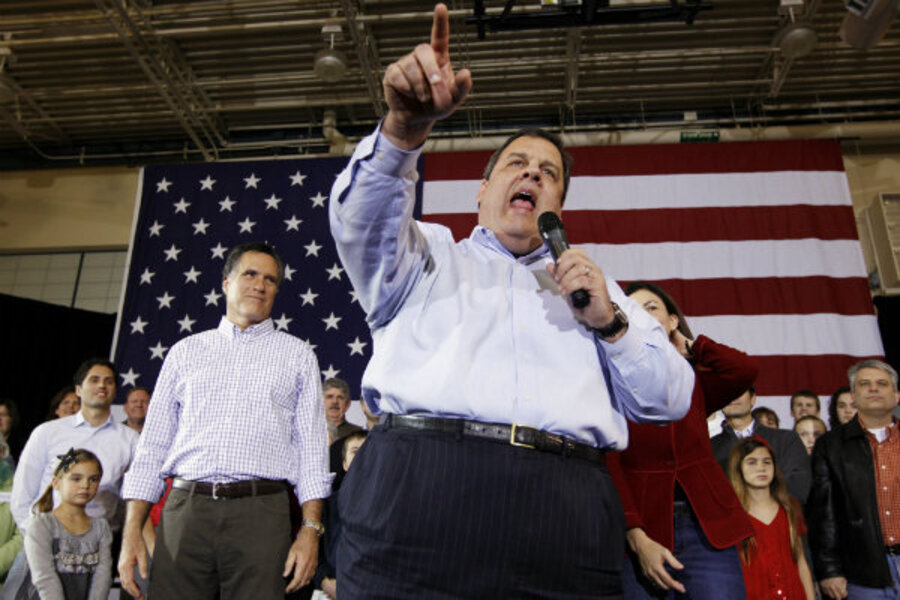Why Romney's choice for vice president could determine America's future
Loading...
| New York
In 1885, a young political scientist named Woodrow Wilson wrote a path-breaking book about the intricacies of American government. Its 344 pages included just one paragraph on the vice presidency, and Wilson wondered if that was too much.
“The chief embarrassment in discussing the office is, that in explaining how little there is to be said about it one has evidently said all there is to say,” Wilson confessed. By the time Wilson became president in 1912, nothing had changed. Can you even name his vice president? I didn’t think so. (Answer: Thomas Marshall.)
But you probably can name the vice presidents after World War II, when the position became much more important. And not for the reasons you might think. Now that Mitt Romney is assured of the GOP nomination, news media have turned their focus to his selection of a running mate. There’s the inevitable talk of “balancing the ticket,” on the assumption that Mr. Romney’s choice will affect his own electoral fortunes.
Yet we have scant evidence that vice presidential nominees have made much of a difference in presidential elections. But they do make a difference once the election is over. Strange as it would have seemed to Woodrow Wilson, Romney is about to anoint a future presidential front-runner.
For most of US history, presidential candidates played virtually no role in choosing their running mates. That was left to the party conventions, which introduced the tradition of ticket-balancing. The vice presidential nominee almost always came from a different region than the presidential one, and if the party had strong internal camps, the “veep” choice could also provide balance on that front.
No president tried to influence this process until 1940, when Franklin Delano Roosevelt threatened to decline his party’s renomination unless it dropped John Nance Garner as his vice president. Garner, who had opposed FDR’s court-packing plan and his unprecedented bid for a third White House term, famously described the vice presidency as “not worth a bucket of warm spit.”
But it became worth a lot more after FDR engineered the nomination of Henry Wallace, setting the modern pattern for presidential selection. Roosevelt would drop Wallace four years later in favor of Harry Truman, who succeeded FDR upon his death in 1945.
And Truman would be elected president in his own right three years after that, establishing another new pattern: The vice presidency has become the best route to the White House. Between Thomas Jefferson and Theodore Roosevelt, only one former vice president – Martin Van Buren – was elected president. Except for Van Buren, no sitting vice president received his party’s nomination for the top job until Richard Nixon in 1960.
But since Truman, three former vice presidents – Lyndon Johnson, Nixon, and George H.W. Bush – have won presidential elections. More to the point, 10 of the last 13 presidential elections have featured at least one candidate who had either served as or been nominated for vice president. In our own day, the nation’s second-in-command automatically becomes a front-runner for commander in chief.
How did that happen? One key factor was the 22nd Amendment to the Constitution in 1951, which barred presidents from serving more than two terms.
Before then, presidential electioneering by a sitting vice president would have been seen as a ploy to undermine the chief executive. Once term limits were instituted, vice presidents could openly campaign for the top post.
Most important, with presidential selection of running mates, the vice president became part of the White House. Under Truman, the vice president joined the National Security Council. When John F. Kennedy became president, Johnson got a suite in the Executive Office Building. With the election of Jimmy Carter, Walter Mondale became the first vice president to work in the West Wing itself. That’s where Joe Biden is today, a few doors down from Barack Obama.
So as Mitt Romney begins vetting possible running mates, let’s stop talking about which one might best balance the ticket. That’s a hangover from the pre-WWII era, when that was all a vice president did. And we still don’t know if it has any effect on electoral outcomes.
Instead, let’s focus on what we do know: Romney’s choice for vice president will almost surely run for president, too. And if Romney wins in November and again in 2016, his choice will be the favorite to win the presidency four years after that.
So as our gaze moves from one possible nominee to another – Marco Rubio, Paul Ryan, Rob Portman, Nikki Haley, Chris Christie, etc. – don’t ask who will help Romney on his path to the Oval Office. Ask who you’d like to see sitting there four or eight years down the road.
Jonathan Zimmerman teaches history and education at New York University. He is the author of “Small Wonder: The Little Red Schoolhouse in History and Memory” (Yale University Press).





